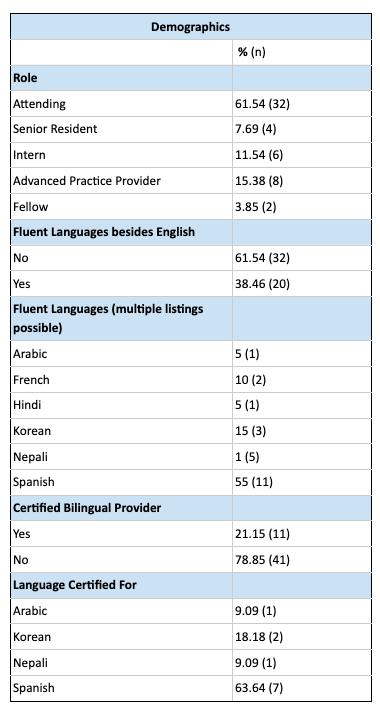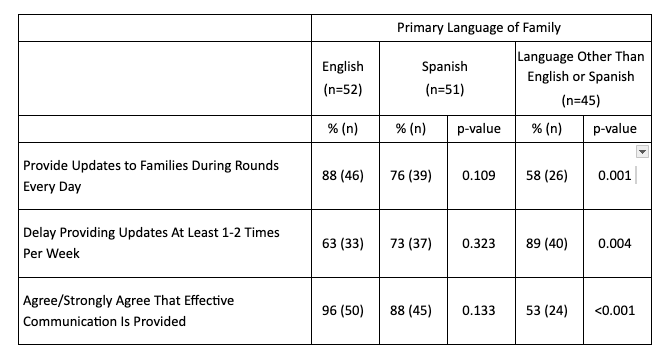Health Equity/Social Determinants of Health 5
Session: Health Equity/Social Determinants of Health 5
715 - Provider perceptions of communication with families preferring languages other than English or Spanish (LotES) in an inpatient pediatric setting
Sunday, April 27, 2025
8:30am - 10:45am HST
Publication Number: 715.6116
Phuong Tran, Children's Hospital Colorado, Denver, CO, United States; Michael B.. Bagg, University of Washington School of Medicine, Seattle, WA, United States; Sonja I. Ziniel, University of Colorado School of Medicine, Aurora, CO, United States; Elizabeth Temte, Children's Hospital Colorado, Denver, CO, United States; Jaime Laurin, Children's Hospital Colorado, Denver, CO, United States; Anna Ruman, University of Colorado School of Medicine, Denver, CO, United States

Phuong Tran, MD (she/her/hers)
Resident
Children's Hospital Colorado
Denver, Colorado, United States
Presenting Author(s)
Background: Hospitalized children and families who prefer languages other than English (LOE) often face barriers to effective communication with their medical teams. However, previous studies have not adequately explored variations in communication by non-English language preference. Specifically, there is limited data on how healthcare providers caring for hospitalized children perceive the effectiveness of communication with families who prefer languages other than English or Spanish (LotES).
Objective: To compare hospitalist and resident perceptions of communication with families preferring LotES to those preferring English or Spanish.
Design/Methods: This survey-based study was conducted at a quaternary children’s hospital. A survey was developed for hospitalists and residents to assess their perceptions of the frequency, timing, and effectiveness of communication based on a family’s language preference: English, Spanish, or LotES. Data were analyzed using descriptive statistics, and perceptions regarding communication effectiveness between families’ language preferences were compared using tests of proportions.
Results: A total of 52 hospitalists and residents completed the survey. The results showed that respondents were less likely to provide updates every day during morning rounds to families preferring LotES (58%, p-value 0.001) compared to families preferring English (88%) or Spanish (76%, p-value 0.109). In addition, 89% (p-value 0.004) of respondents reported delaying medical updates at least 1-2 times/week for families preferring LotES compared to families preferring English (63%) or Spanish (73%, p-value 0.323). Only 53% (p-value < 0.001) of respondents agreed or strongly agreed that their teams effectively communicated with families preferring LotES compared to families preferring English (96%) or Spanish (88%, p-value 0.133). The most commonly reported barriers to timely communication with families preferring LOE included: challenges with interpretation access (29%), time constraints (25%), and families not being present (21%).
Conclusion(s):
Discussion: Families preferring LotES experience delayed, less frequent, and less effective communication about their child’s medical care while hospitalized. Study limitations include reliance on self-reported communication with families rather than observational measures. Future efforts are needed to directly observe, understand, and promote equitable communication with this patient population.
Demographic Characteristics of Survey Respondents (n=52)

Provider-Reported Practices Regarding Communication with Families by Language Preference

Demographic Characteristics of Survey Respondents (n=52)

Provider-Reported Practices Regarding Communication with Families by Language Preference


